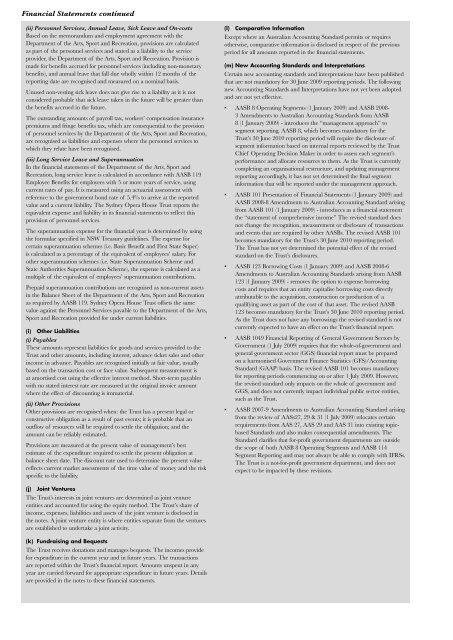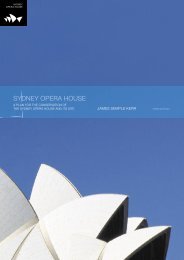Sydney Opera House Annual Report 2008/09
Sydney Opera House Annual Report 2008/09
Sydney Opera House Annual Report 2008/09
You also want an ePaper? Increase the reach of your titles
YUMPU automatically turns print PDFs into web optimized ePapers that Google loves.
Financial Statements continued(ii) Personnel Services, <strong>Annual</strong> Leave, Sick Leave and On-costsBased on the memorandum and employment agreement with theDepartment of the Arts, Sport and Recreation, provisions are calculatedas part of the personnel services and stated as a liability to the serviceprovider, the Department of the Arts, Sport and Recreation. Provision ismade for benefits accrued for personnel services (including non-monetarybenefits), and annual leave that fall due wholly within 12 months of thereporting date are recognised and measured on a nominal basis.unused non-vesting sick leave does not give rise to a liability as it is notconsidered probable that sick leave taken in the future will be greater thanthe benefits accrued in the future.The outstanding amounts of payroll tax, workers’ compensation insurancepremiums and fringe benefits tax, which are consequential to the provisionof personnel services by the Department of the Arts, Sport and Recreation,are recognised as liabilities and expenses where the personnel services towhich they relate have been recognised.(iii) Long Service Leave and SuperannuationIn the financial statements of the Department of the Arts, Sport andRecreation, long service leave is calculated in accordance with AASB 119Employee Benefits for employees with 5 or more years of service, usingcurrent rates of pay. It is measured using an actuarial assessment withreference to the government bond rate of 5.4% to arrive at the reportedvalue and a current liability. The <strong>Sydney</strong> <strong>Opera</strong> <strong>House</strong> Trust reports theequivalent expense and liability in its financial statements to reflect thisprovision of personnel services.The superannuation expense for the financial year is determined by usingthe formulae specified in NSW Treasury guidelines. The expense forcertain superannuation schemes (i.e. Basic Benefit and First State Super)is calculated as a percentage of the equivalent of employees’ salary. Forother superannuation schemes (i.e. State Superannuation Scheme andState Authorities Superannuation Scheme), the expense is calculated as amultiple of the equivalent of employees’ superannuation contributions.Prepaid superannuation contributions are recognised as non-current assetsin the Balance Sheet of the Department of the Arts, Sport and Recreationas required by AASB 119. <strong>Sydney</strong> <strong>Opera</strong> <strong>House</strong> Trust offsets the samevalue against the Personnel Services payable to the Department of the Arts,Sport and Recreation provided for under current liabilities.(i) Other Liabilities(i) PayablesThese amounts represent liabilities for goods and services provided to theTrust and other amounts, including interest, advance ticket sales and otherincome in advance. Payables are recognised initially at fair value, usuallybased on the transaction cost or face value. Subsequent measurement isat amortised cost using the effective interest method. Short-term payableswith no stated interest rate are measured at the original invoice amountwhere the effect of discounting is immaterial.(ii) Other ProvisionsOther provisions are recognised when: the Trust has a present legal or constructive obligation as a result of past events; it is probable that an outflow of resources will be required to settle the obligation; and theamount can be reliably estimated. Provisions are measured at the present value of management’s bestestimate of the expenditure required to settle the present obligation atbalance sheet date. The discount rate used to determine the present valuereflects current market assessments of the time value of money and the riskspecific to the liability.(l) Comparative InformationExcept where an Australian Accounting Standard permits or requiresotherwise, comparative information is disclosed in respect of the previousperiod for all amounts reported in the financial statements.(m) New Accounting Standards and InterpretationsCertain new accounting standards and interpretations have been publishedthat are not mandatory for 30 June 20<strong>09</strong> reporting periods. The followingnew Accounting Standards and Interpretations have not yet been adoptedand are not yet effective.• AASB 8 <strong>Opera</strong>ting Segments (1 January 20<strong>09</strong>) and AASB <strong>2008</strong>‐3 Amendments to Australian Accounting Standards from AASB8 (1 January 20<strong>09</strong>) - introduces the “management approach” tosegment reporting. AASB 8, which becomes mandatory for theTrust’s 30 June 2010 reporting period will require the disclosure ofsegment information based on internal reports reviewed by the TrustChief <strong>Opera</strong>ting Decision Maker in order to assess each segment’sperformance and allocate resources to them. As the Trust is currentlycompleting an organisational restructure, and updating managementreporting accordingly, it has not yet determined the final segmentinformation that will be reported under the management approach.• AASB 101 Presentation of Financial Statements (1 January 20<strong>09</strong>) andAASB <strong>2008</strong>-8 Amendments to Australian Accounting Standard arisingfrom AASB 101 (1 January 20<strong>09</strong>) - introduces as a financial statementthe “statement of comprehensive income” The revised standard doesnot change the recognition, measurement or disclosure of transactionsand events that are required by other AASBs. The revised AASB 101becomes mandatory for the Trust’s 30 June 2010 reporting period.The Trust has not yet determined the potential effect of the revisedstandard on the Trust’s disclosures.• AASB 123 Borrowing Costs (1 January 20<strong>09</strong>) and AASB <strong>2008</strong>‐6Amendments to Australian Accounting Standards arising from AASB123 (1 January 20<strong>09</strong>) - removes the option to expense borrowingcosts and requires that an entity capitalise borrowing costs directlyattributable to the acquisition, construction or production of aqualifying asset as part of the cost of that asset. The revised AASB123 becomes mandatory for the Trust’s 30 June 2010 reporting period.As the Trust does not have any borrowings the revised standard is notcurrently expected to have an effect on the Trust’s financial report.• AASB 1049 Financial <strong>Report</strong>ing of General Government Sectors byGovernment (1 July 20<strong>09</strong>) requires that the whole-of-government andgeneral government sector (GGS) financial report must be preparedon a harmonised Government Finance Statistics (GFS)/AccountingStandard (GAAP) basis. The revised AASB 101 becomes mandatoryfor reporting periods commencing on or after 1 July 20<strong>09</strong>. However,the revised standard only impacts on the whole of government andGGS, and does not currently impact individual public sector entities,such as the Trust.• AASB 2007‐9 Amendments to Australian Accounting Standard arisingfrom the review of AASs27, 29 & 31 (1 July 20<strong>09</strong>) relocates certainrequirements from AAS 27, AAS 29 and AAS 31 into existing topicbasedStandards and also makes consequential amendments. TheStandard clarifies that for-profit government departments are outsidethe scope of both AASB 8 <strong>Opera</strong>ting Segments and AASB 114Segment <strong>Report</strong>ing and may not always be able to comply with IFRSs.The Trust is a not-for-profit government department, and does notexpect to be impacted by these revisions.(j) Joint VenturesThe Trust’s interests in joint ventures are determined as joint ventureentities and accounted for using the equity method. The Trust’s share ofincome, expenses, liabilities and assets of the joint venture is disclosed inthe notes. A joint venture entity is where entities separate from the venturesare established to undertake a joint activity.(k) Fundraising and BequestsThe Trust receives donations and manages bequests. The incomes providefor expenditure in the current year and in future years. The transactionsare reported within the Trust’s financial report. Amounts unspent in anyyear are carried forward for appropriate expenditure in future years. Detailsare provided in the notes to these financial statements.

















